
Black Guillemot
| Irish Name: | Foracha dhubh |
| Scientific name: | Cepphus grylle |
| Bird Family: | Auks |
amber
Conservation status
Conservation status
Status
Resident along all Irish coasts.
Identification
A species of Auk, highly marine and only found on land in the breeding season. Smaller than Guillemot, and only slightly bigger than Puffin. Plump and heavy at the rear end, flies with head pointing up. Strikingly distinctive in the breeding season, with an all black plumage, white upperwing patches and red feet. Can look all dark, at a distance, in the breeding season. Very different in the winter when the bird is white below with white barring above, upperwing pattern very similar to the breeding season and useful in identifying the species at that time of year.
Voice
Displaying birds voice a series of fine notes.
Diet
Marine fish and crustaceans.
Breeding
Nests amongst boulders at the base of cliffs, also in rock crevices and in man made structures, such as piers. Will nest singularly and in loose colonies.
Wintering
Winters in the vicinity of its breeding sites and can be seen inshore throughout the year.
Monitored by
Breeding seabirds are monitored through seabird surveys carried out every 15-20 years.
Blog posts about this bird

Rockablog: Preparing Rockabill Island for the 2024 season
Led by Project Manager Dr. Stephen Newton, the three Rockabill wardens have eagerly begun our NPWS-funded work on Rockabill and are very excited for what the season will bring. We have already been here for two weeks, and what a fortnight it has been!
In just 14 days, Rockabill has transformed into a hub of seabird activity. The island has gotten progressively noisier, resonating with the calls of black Guillemots and Kittiwakes, and now, of Common Terns, Arctic Terns, and Roseate Terns. Our days have been filled to the brim with preparations, ensuring that the island is primed and ready to accommodate the nesting needs of these birds.







Meet the Rockabill Wardens

Rockabill’s 2024 resident tern wardens- Emma (left), Kyle (middle), and Rochelle (right).
Rochelle Streker This is Rochelle’s first season as a warden on Rockabill, having moved to Ireland from the United States last year. Rochelle has lots of seabird and conservation experience all across America, including working with and surveying Black Skimmers, Wilson’s Plovers, Red Knots, Newell’s Shearwaters, American Oystercatchers, Marbled Murrelets, Bald Eagles, and many different species of terns. She has also completed a master’s in wildlife biology from Clemson University on the reproductive ecology of Brown Pelicans in the northern Gulf of Mexico. As she settles into her new Irish life in Dublin, she is looking forward to learning more about Irish conservation and having a great season out on Rockabill! Emma Roberts Emma, a newcomer to the Rockabill warden team, holds a zoology degree from the University of Galway and is nearing completion of her PhD focused on urban red squirrel ecology. During her time in Galway, Emma volunteered with the Galway and Claddagh Swan Rescue and devoted her time to rescuing and rehabilitating, injured birds, including feral pigeons, Woodpigeons, Mute Swans, Herring Gulls, Black-headed Gulls, Mallards, Grey Herons, and the occasional Guillemot! Emma, an enthusiastic bird watcher with a particular affinity for seabirds, is very excited to learn more about seabird conservation and kickstart her career with a season on Rockabill. Kyle Coughlan Kyle is a Dublin native and studied for his B.Sc. in Zoology and M.Sc. in Evolutionary Biology at UCD and returned to Ireland in April after nearly seven years abroad. Following university studies, he spent a year working with in the south of France with a group focused on the conservation of the European Roller. Then he worked towards at Ph.D. at the Jagiellonian University in Krakow where he studied Great Tits and Blue Tits in the forests of northern Poland. Having recently submitted his thesis he is very much looking forward to spending his first summer on Rockabill with the terns.Preparing the Island
After arriving at Rockabill on the 24th of April, the three of us and Steve quickly began preparing the island for the arrival of the Common, Roseate, and Arctic terns. Additionally, we've been observing the activity of the Black Guillemots and Kittiwakes that have already arrived on Rockabill and have begun searching for nesting sites. As the black guillemots are already on the island, we quickly began setting up nest boxes for them. These birds favour nesting in secluded, dark crevices within rocky formations. So far, we have set up black guillemot nest boxes beneath the Helipad, a preferred nesting spot for these birds, and on the rocks to the north of the island where we've observed pairs congregating.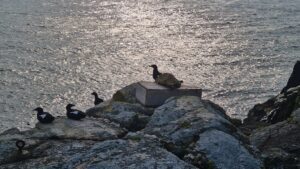

Black Guillemot pairs checking out the nest boxes on the rocks to the north of the island (top) and under the helipad (bottom).
The main island is called the “Rock” and the smaller rocky island is called the “Bill”. While the Bill has very little vegetation, the Rock is covered in a densely growing plant called tree mallow. It takes up so much of the ground area on the island that there is no room for common, arctic, and roseate tern nests. Its swift removal was our next port of call. First, we removed the tree mallow from our study sites and then went about removing it from the remainder of the main island. We also had to organise our nest boxes for the Roseate Terns. The nest boxes were taken out of storage and organised by number from 00 to 948! Some of the boxes were broken or damaged during the last breeding season, so these boxes were repaired if feasible. Additionally, new boxes were constructed and labelled with ID numbers to fill any gaps. With a considerable number of nest boxes on hand, our aim is to maximize nesting opportunities for the roseate terns by deploying as many boxes as we can.
Roseate Tern nest boxes.
Next came the 5 hides, which are required to monitor the nesting terns without disturbing them. We assembled the hides at vantage points across the island. They were then weighed down with heavy rocks and tied down with rope in order to prevent them from being blown away in any storms. Luckily, we got the hides set up and secured in time for our first stormy day!

2 of the 5 hides set up around the main island.
On Saturday the 27th of April, we were visited by the Geological Society of Ireland, who spent a few hours on the island looking at Rockabill Granite. The members of the GSI were kind enough to help us remove tree mallow from various study sites. We really appreciated having more hands to help us with the removal! When the GSI left that evening, Steve joined them and headed back to the mainland. With Steve’s departure us wardens got busy setting up all of the Roseate Tern nest boxes around the island. First, we set up boxes around each of the assigned study sites, which can be monitored from the hides. Next, we started setting up the remainder of the nest boxes around the island. Aside from two stormy days with strong winds, rain, and high waves, we have been very lucky with the weather. A succession of clear days allowed us to finish setting up all of the nest boxes. Just in the nick of time too because this week- the terns arrived! First, the terns started circling the lighthouse in the AM. Every day they began flying lower and lower to the ground. Now, plenty of them have started landing on the island and looking for places to nest. We have spotted all 3 species of tern so far; Common Terns, Roseate Terns, and Arctic Terns. With their arrival, the island has gotten progressively noisier. We are very excited for them to start nesting so that we can continue to monitor them and start ring reading. And there you have it! Stay tuned for more updates as we navigate through the season's tern of events. - Emma, Rochelle, and Kyle This year’s work to protect and monitor the terns and other breeding seabirds on Rockabill would not be possible without the support from the National Parks and Wildlife Service and the cooperation of the Commissioners of Irish Lights.

All Grown Up and Ready to Ring
Life continues to move fast out here on Rockabill. This year we recorded a record number of Roseate Tern nests on the island. That is a lot of chicks to watch over! Not only that, but each of these chicks need to be ringed with a uniquely coded leg ring so that we can continue to monitor them after they migrate and when they hopefully return to Rockabill to nest in the years to come. In no time at all our tiny tern chicks had shed their fluffy down feathers and had grown into their more elegant flight feathers.
Common tern chicks will start to wander away from their nest as early as 1 or 2 days old. Roseate tern chicks on the other hand will wait a bit longer and at 10 to 15 days old they will start to investigate the world outside their nest boxes.
It’s not just the terns, the Black Guillemots and Kittiwakes have also been getting very big, very fast.


The week concluded with the Steve and the volunteers’ departure, leaving the wardens to look after more and more fledglings by the day. However, we were not left for too long, as a few weeks later it was time to go climbing to ring some Kittiwake chicks. Dr. Stephen Newton returned with work experience student Hannah O’ Connor, who helped us earlier in the season with the nest census, and we set off. As Kittiwakes are cliff nesting seabirds, catching some of the chicks for ringing required some Micheal’s rock climbing expertise.
We set to work and over the course of two days, we ringed 174 Kittiwake chicks on the Bill and on the Rock.
While its always enjoyable to find fluffy Kittiwake chicks, the work was made a bit more difficult as we worked through the recent heatwave. At the end of each day the wardens and Hannah enjoyed a well-deserved swim in the sea. After a very sweaty few days, it was time for Dr Newton to leave us again and we were once again left to our own devices, this time, however, on an island bustling with teams of busy fledglings, as they took to the air for the first time.
 Common Tern chicks at different stages of their growth. Photos by Emma Tiernan, taken under NPWS license.
Common Tern chicks at different stages of their growth. Photos by Emma Tiernan, taken under NPWS license.
 Roseate tern chicks at different stages of their growth. Photos by Emma Tiernan & Alex Fink, taken under NPWS license.
Roseate tern chicks at different stages of their growth. Photos by Emma Tiernan & Alex Fink, taken under NPWS license.
Common tern chicks will start to wander away from their nest as early as 1 or 2 days old. Roseate tern chicks on the other hand will wait a bit longer and at 10 to 15 days old they will start to investigate the world outside their nest boxes.
 Common tern chick cosy under their parent on a cold day. Photo by Emma Tiernan, taken under NPWS license.
Common tern chick cosy under their parent on a cold day. Photo by Emma Tiernan, taken under NPWS license.
 Roseate tern chicks from the same clutch stepping outside their nest box for the first time. Photo by Emma Tiernan, taken under NPWS license.
Roseate tern chicks from the same clutch stepping outside their nest box for the first time. Photo by Emma Tiernan, taken under NPWS license.
It’s not just the terns, the Black Guillemots and Kittiwakes have also been getting very big, very fast.
 Black Guillemots at 5 days old (left) and over 15 days old (right) before getting weighed for biometrics analysis. Photos by Emma Tiernan, taken under NPWS license.
Black Guillemots at 5 days old (left) and over 15 days old (right) before getting weighed for biometrics analysis. Photos by Emma Tiernan, taken under NPWS license.
 Kittiwake chicks at 5 days old (left) and over 20 days old (right), now almost ready to fledge. Photos by Emma Tiernan & Alex Fink, taken under NPWS license.
Kittiwake chicks at 5 days old (left) and over 20 days old (right), now almost ready to fledge. Photos by Emma Tiernan & Alex Fink, taken under NPWS license.
Ringing Takes Time
As the tern chicks continued to grow throughout June it wasn’t long before it was time for the annual ringing blitz. While we had each ringed the majority of Roseate and common Tern chicks within our study areas, thousands of chicks still remained to be ringed around the rest of the island. We definitely would not be able to accomplish this with just the three of us. Thankfully, on the 28th of June, we were joined by Dr Stephen Newton, BirdWatch staff Brian Burke and Tara Adcock, and ringers Caroline McKeon and Thorfinn Newton to help us with this daunting task. Bird ringing is strictly licensed in Ireland through both the NPWS and BTO and requires extensive training before licenses are granted! We spent the next 3 days sweeping through each sub-colony of the island, systematically searching every box and nest location to catch and ring every Roseate and Common Tern chick that could be found. Once caught, the chicks were given a uniquely-coded metal ring and Dr. Newton recorded the ring number and other important details including the species, location and wing size (which gives us an idea of how many days old that chick is). Once ringed, the chick was released in its original setting and we moved on with our search. It was a tedious job, but with the help of the volunteers and some good weather, we managed to get the bulk of this ringing completed quickly. Warden Micheal Fitzgearld and ringer Caroline McKeon busy ringing Common and Roseate chicks. Photo by Emma Tiernan, taken under NPWS license.
Warden Micheal Fitzgearld and ringer Caroline McKeon busy ringing Common and Roseate chicks. Photo by Emma Tiernan, taken under NPWS license.

Tara Adcock ringing a young Common Tern chick. Photo by Emma Tiernan, taken under NPWS license.
Good News for our Arctic Terns
We are lucky to have thirty-seven Arctic Tern pairs nesting on the Rock this year. In previous breeding seasons, Arctic tern chicks out here have not been very lucky and most nest have been destroyed by either predation or wet weather. However, this year is looking good for our Arctic terns and 17 chicks have fledged. Fifteen Arctic chicks were fitted with BTO and special colour rings. Keep an eye out for some Arctic Terns along the East coast wearing a black ring with 2 white letters on the left leg. Dr Steven Newton colour ringing an Arctic Tern chick. Photo by Emma Tiernan, taken under NPWS license.
Dr Steven Newton colour ringing an Arctic Tern chick. Photo by Emma Tiernan, taken under NPWS license.
 An adult Arctic Tern with a colour ring (black 'E5') on the right leg. Hopefully this years fledglings will return to Rockabill in the coming years! Photo by Brian Burke, taken under NPWS license.
An adult Arctic Tern with a colour ring (black 'E5') on the right leg. Hopefully this years fledglings will return to Rockabill in the coming years! Photo by Brian Burke, taken under NPWS license.
Climbing for Kittiwakes
There were more than just Tern chicks to ring however, and with the majority of this work completed we set about catching adult Kittiwakes from the cliff tops on the Rock. Kittiwakes are now globally red-listed, so we’re trying to increase our monitoring of this beautiful gull on Rockabill. As well as ringing them, we also attached GLS tags to each one so that their movements over the next fifteen months could be tracked. All in all, we caught twenty of these beautiful birds over the course of two days.
 Kittiwake with a GLS tag (on the green ring), plus identifying metal and colour rings, before being released back into the colony. Photo by Brian Burke.
Kittiwake with a GLS tag (on the green ring), plus identifying metal and colour rings, before being released back into the colony. Photo by Brian Burke.
The week concluded with the Steve and the volunteers’ departure, leaving the wardens to look after more and more fledglings by the day. However, we were not left for too long, as a few weeks later it was time to go climbing to ring some Kittiwake chicks. Dr. Stephen Newton returned with work experience student Hannah O’ Connor, who helped us earlier in the season with the nest census, and we set off. As Kittiwakes are cliff nesting seabirds, catching some of the chicks for ringing required some Micheal’s rock climbing expertise.
 Warden Micheal Fitzgerald has been a keen rock climber for years and was looking forward to climbing cliffs for Kittiwakes, Photo by Emma Tiernan.
Warden Micheal Fitzgerald has been a keen rock climber for years and was looking forward to climbing cliffs for Kittiwakes, Photo by Emma Tiernan.
We set to work and over the course of two days, we ringed 174 Kittiwake chicks on the Bill and on the Rock.
 The Rockabill team ringing Kittiwake chicks while Micheal waits to carefully put them back in their nests. Photo by Emma Tiernan, taken under NPWS license.
The Rockabill team ringing Kittiwake chicks while Micheal waits to carefully put them back in their nests. Photo by Emma Tiernan, taken under NPWS license.
While its always enjoyable to find fluffy Kittiwake chicks, the work was made a bit more difficult as we worked through the recent heatwave. At the end of each day the wardens and Hannah enjoyed a well-deserved swim in the sea. After a very sweaty few days, it was time for Dr Newton to leave us again and we were once again left to our own devices, this time, however, on an island bustling with teams of busy fledglings, as they took to the air for the first time.
- Micheal, Emma and Alex, Rockabill Team
(PS – Don’t forget to keep an eye out for terns roosting around the coast at this time of year, and let us know via the link here)This year’s work to protect and monitor the terns and other breeding seabirds on Rockabill would not be possible without support from the National Parks and Wildlife Service and the cooperation of the Commissioners of Irish Lights.
To revisit news and blogs from previous years on Rockabill, click the link here.




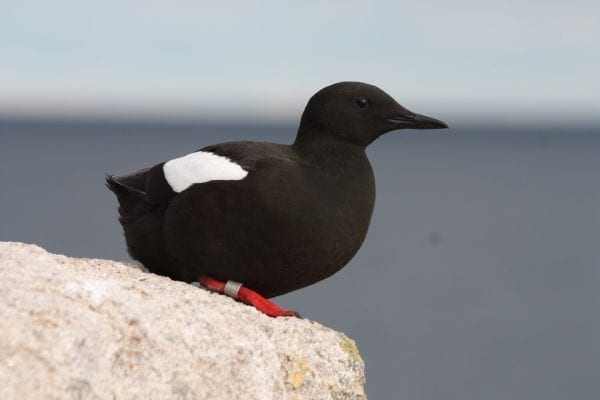
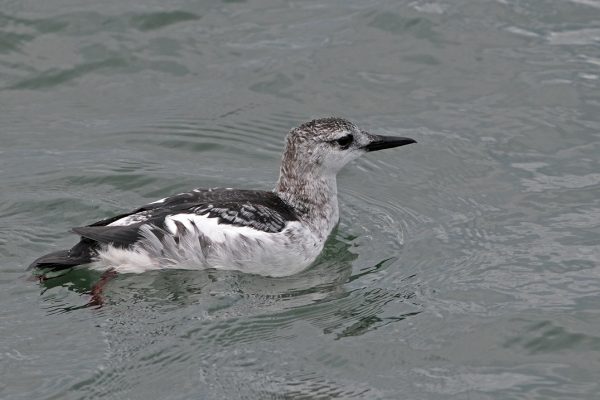
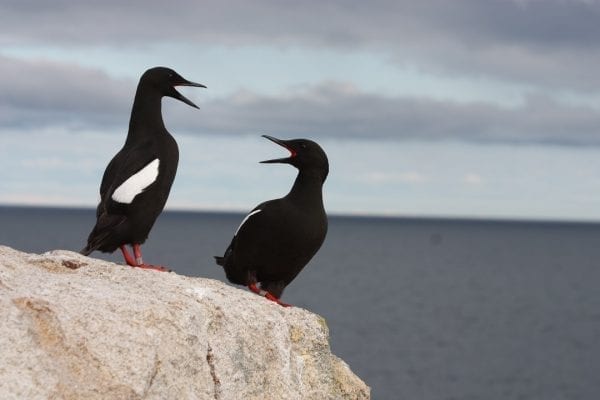

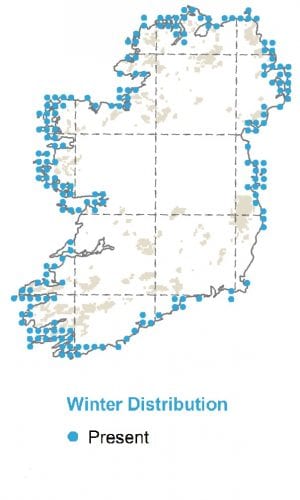
 Common Tern chicks at different stages of their growth. Photos by Emma Tiernan, taken under NPWS license.
Common Tern chicks at different stages of their growth. Photos by Emma Tiernan, taken under NPWS license. Roseate tern chicks at different stages of their growth. Photos by Emma Tiernan & Alex Fink, taken under NPWS license.
Roseate tern chicks at different stages of their growth. Photos by Emma Tiernan & Alex Fink, taken under NPWS license. Common tern chick cosy under their parent on a cold day. Photo by Emma Tiernan, taken under NPWS license.
Common tern chick cosy under their parent on a cold day. Photo by Emma Tiernan, taken under NPWS license. Roseate tern chicks from the same clutch stepping outside their nest box for the first time. Photo by Emma Tiernan, taken under NPWS license.
Roseate tern chicks from the same clutch stepping outside their nest box for the first time. Photo by Emma Tiernan, taken under NPWS license. Black Guillemots at 5 days old (left) and over 15 days old (right) before getting weighed for biometrics analysis. Photos by Emma Tiernan, taken under NPWS license.
Black Guillemots at 5 days old (left) and over 15 days old (right) before getting weighed for biometrics analysis. Photos by Emma Tiernan, taken under NPWS license. Kittiwake chicks at 5 days old (left) and over 20 days old (right), now almost ready to fledge. Photos by Emma Tiernan & Alex Fink, taken under NPWS license.
Kittiwake chicks at 5 days old (left) and over 20 days old (right), now almost ready to fledge. Photos by Emma Tiernan & Alex Fink, taken under NPWS license. Warden Micheal Fitzgearld and ringer Caroline McKeon busy ringing Common and Roseate chicks. Photo by Emma Tiernan, taken under NPWS license.
Warden Micheal Fitzgearld and ringer Caroline McKeon busy ringing Common and Roseate chicks. Photo by Emma Tiernan, taken under NPWS license. Dr Steven Newton colour ringing an Arctic Tern chick. Photo by Emma Tiernan, taken under NPWS license.
Dr Steven Newton colour ringing an Arctic Tern chick. Photo by Emma Tiernan, taken under NPWS license.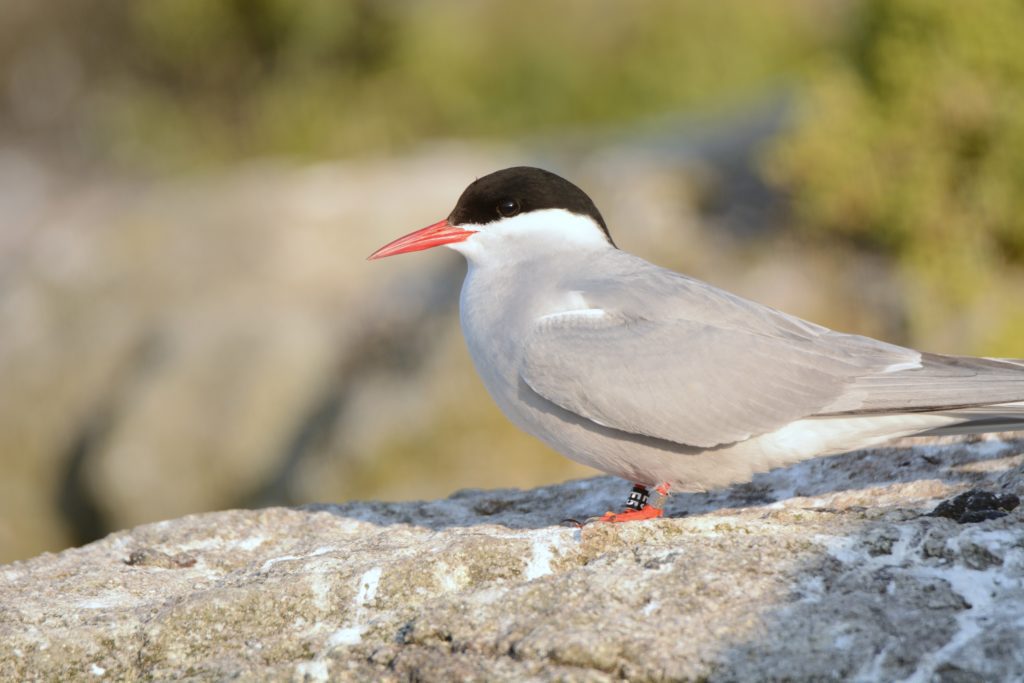 An adult Arctic Tern with a colour ring (black 'E5') on the right leg. Hopefully this years fledglings will return to Rockabill in the coming years! Photo by Brian Burke, taken under NPWS license.
An adult Arctic Tern with a colour ring (black 'E5') on the right leg. Hopefully this years fledglings will return to Rockabill in the coming years! Photo by Brian Burke, taken under NPWS license. Kittiwake with a GLS tag (on the green ring), plus identifying metal and colour rings, before being released back into the colony. Photo by Brian Burke.
Kittiwake with a GLS tag (on the green ring), plus identifying metal and colour rings, before being released back into the colony. Photo by Brian Burke. Warden Micheal Fitzgerald has been a keen rock climber for years and was looking forward to climbing cliffs for Kittiwakes, Photo by Emma Tiernan.
Warden Micheal Fitzgerald has been a keen rock climber for years and was looking forward to climbing cliffs for Kittiwakes, Photo by Emma Tiernan. The Rockabill team ringing Kittiwake chicks while Micheal waits to carefully put them back in their nests. Photo by Emma Tiernan, taken under NPWS license.
The Rockabill team ringing Kittiwake chicks while Micheal waits to carefully put them back in their nests. Photo by Emma Tiernan, taken under NPWS license.

